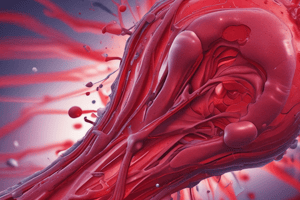Podcast
Questions and Answers
What is the function of albumin in plasma?
What is the function of albumin in plasma?
- Fight infection
- Transport substances around the body
- Regulates osmosis between blood and tissues (correct)
- Used in blood clotting
Which cell type in blood is responsible for transporting oxygen around the body?
Which cell type in blood is responsible for transporting oxygen around the body?
- Red blood cells (correct)
- Platelets
- White blood cells
- Plasma cells
What is the primary function of fibrinogen found in plasma?
What is the primary function of fibrinogen found in plasma?
- Regulates osmosis between blood and tissues
- Used in blood clotting (correct)
- Transport substances around the body
- Fight infection
Which characteristic of red blood cells distinguishes them from other cells?
Which characteristic of red blood cells distinguishes them from other cells?
What is the range of colors observed in blood vessels due to?
What is the range of colors observed in blood vessels due to?
How does the viscosity of blood compare to water?
How does the viscosity of blood compare to water?
Which type of white blood cell is responsible for releasing histamines to dilate blood vessels during an infection?
Which type of white blood cell is responsible for releasing histamines to dilate blood vessels during an infection?
In the process of hemostasis, what occurs after the formation of a vascular spasm and a platelet plug?
In the process of hemostasis, what occurs after the formation of a vascular spasm and a platelet plug?
What is the primary function of platelets in the bloodstream?
What is the primary function of platelets in the bloodstream?
What is the function of monocytes after they leave the blood and enter surrounding tissues?
What is the function of monocytes after they leave the blood and enter surrounding tissues?
What are the most common signs of a transfusion reaction, indicating a serious response?
What are the most common signs of a transfusion reaction, indicating a serious response?
What distinguishes the Rh blood group system from the ABO blood group system?
What distinguishes the Rh blood group system from the ABO blood group system?
Flashcards are hidden until you start studying
Study Notes
Functions of Blood
- Transports oxygen, waste, and hormones
- Prevents infection and blood loss
- Regulates body temperature, pH, and fluid volume
Composition and Characteristics of Whole Blood
- Blood is a connective tissue made of cells suspended in a fluid matrix (plasma)
- Suspended cells are known as formed elements (red blood cells, white blood cells, and platelets)
- Plasma composition: 90% water, 10% dissolved gases, salts, minerals, nutrients, enzymes, hormones, waste, and proteins
- Three types of proteins in plasma: Albumin (regulates osmosis), Globulins (transport substances or fight infection), and Fibrinogen (used in blood clotting)
- Physical characteristics: 5 times more viscous than water, color ranges from bright red to purplish, pH range of 7.35-7.45, and blood volume of 5-6 liters
Erythrocytes (Red Blood Cells)
- Structure: biconcave shape, round sides, no nucleus, and few organelles
- Function: transport oxygen around the body via hemoglobin
- Production: produced in red bone marrow, assist in Hematopoiesis, and lives only 100-120 days
White Blood Cells (WBCs)
- Granulocytes:
- Neutrophils: engulf and destroy foreign bacteria, most common leukocyte, and more are produced during an infection
- Basophils: release histamines, which dilate blood vessels
- Eosinophils: kill parasitic worms and lessen allergic reactions
- Agranulocytes:
- Lymphocytes: antibody production, direct cell-mediated killing of virus-infected and tumor cells, and regulation of the immune response (2 types: T-cells and B-cells)
- Monocytes: leave the blood and enter surrounding tissues, becoming macrophages that attack and engulf viruses, parasites, and bacterial infections
Platelets
- Structure: made of tiny fragments of other cells
- Function: clotting the blood when a vessel is broken
- Production: formed and released into the bloodstream by precursor cells called megakaryocytes in the bone marrow
Hemostasis
- Vascular spasms
- Platelet plug formation
- Coagulation
- Clot Retraction and Repair
ABO and Rh Blood Groups
- ABO blood groups: A, B, AB, O
- Antigens and antibodies: antigens trigger antibody production, leading to agglutination
- Rh factor: determined by the presence or absence of an Rh antigen on red blood cells
- Rh+ and Rh- individuals: Rh- people form anti-Rh antibodies when they come in contact with Rh+ blood
- Transfusion reactions: symptoms include fever, chills, urticaria, itching, and potentially serious reactions such as respiratory distress, high fever, hypotension, and red urine (hemoglobinuria)
Studying That Suits You
Use AI to generate personalized quizzes and flashcards to suit your learning preferences.




